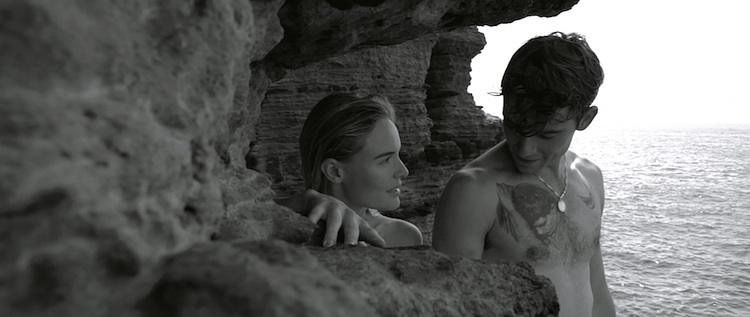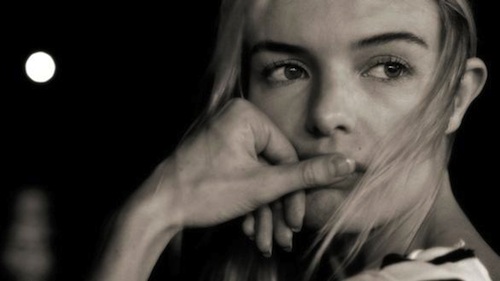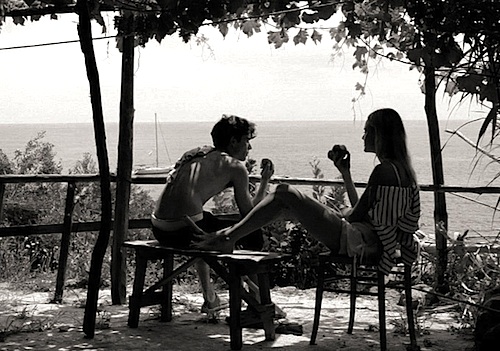By Govindini Murty. Kat Coiro’s While We Were Here (see a clip above) is the latest in a tradition of stories about travelers whose lives are transformed by Italy. From Goethe’s famous trip to Italy and its echoes in his Wilhelm Meister novels to William Wyler’s Roman Holiday, Merchant Ivory’s A Room With a View, and Mike Newell’s Enchanted April, Italy has long worked its magic on voyagers to its mythic shores.
While We Were Here presents an understated variation on this familiar theme. Jane (Kate Bosworth), a quiet and somewhat melancholy writer, journeys to southern Italy with her husband, the dour Leonard (Iddo Goldberg). Leonard, a viola player, has been invited to perform in a concert in Naples. While Leonard spends his days in rehearsal, Jane wanders the streets of Naples, experiencing life at second-hand. The mediated nature of Jane’s existence is reinforced by the fact that rather than interact with any of the locals, she spends her time listening to tape-recorded conversations of her Grandmother Eves (Claire Bloom) discussing her experiences during WWII. All this is purportedly for a book that Jane is writing, but Grandma Eves’ lively reminiscences about life during the war form a pointed contrast to Jane’s anomie in the peace and plenty of the present. One day Jane makes an impulsive decision to take a ferry to the island of Ischia off the coast of Naples – and there falls into a romance with an American lad named Caleb (Jamie Blackley) living a carefree existence on the island.

While We Were Here is essentially a three-character chamber drama that plays outdoors in the glorious settings of Naples and Ischia. All the character’s problems are of an internal nature. Jane and Leonard have marriage problems, but even as Jane tries to address them, the gloomy Leonard prefers to disappear into the work of his viola rehearsals. Jane wants to write a book about her grandmother’s experiences in WWII, but she’s worried she can’t make the book interesting because of a lack of engagement on her part.

As for Caleb, his disruptive influence on Jane and Leonard’s lives is overtly likened to that of Dionysus, with one scene taking place in a grape arbor on Ischia and Caleb himself somewhat resembling Caravaggio’s portrait of the vine-bedecked god. However, even as Caleb pursues Jane, he has no job and no plans for his life. He quotes Vittoria Colonna’s sonnets to Michelangelo as he and Jane tour an Aragonese castle, he takes Jane riding on a scooter and swimming in the ocean, but their relationship doesn’t seem destined for much more than that. Indeed, it seems to be her grandmother’s voice-over about the fun she had with her American and Belgian boyfriends during WWII that spurs Jane on to her affair with Caleb in the first place. Ultimately, Jane makes her own choices, but the person having the most fun with life in the film may just be Claire Bloom’s earthy, albeit unseen, Grandma Eves.
While We Were Here is not only an homage to the great “voyage to Italy” films, but, with its black and white cinematography, also evokes the look of classic Italian Neorealist drama. As Jane wanders through the narrow streets of Spaccanapoli, one would almost expect a young Sophia Loren, in her role as a voluptuous pizza maker in De Sica’s The Gold of Naples, to appear around the corner. And though Kate Bosworth might be the physical opposite of Sophia Loren, her slim blonde beauty and reserved quality do resemble that of such ‘60s actresses as the pixyish Jean Seberg from Godard’s Breathless (even down to the striped sailor top) and the cool, lovely Monica Vitti in Antonioni’s masterpiece of alienation, L’Avventura. Beyond looks though, Bosworth’s strong, sensitive acting forms the emotional core of the film (in particular in one standout scene with Goldberg’s Leonard), and she and Blackley have a number of amusing scenes in which their easy banter make the movie eminently watchable.

Regardless, it’s enough for me that the film is set in Naples and Ischia. Naples is one of my favorite cities, and although I haven’t yet made it to Ischia (I opted for Capri instead on a trip some years ago), it was delightful to see again the streets and sights of old Neapolis. I have many fond memories of wandering the narrow thoroughfares of Spaccanapoli (under which lie ancient Roman streets), down the long Via Toledo, through the 19th century glass and wrought iron Galleria Umberto I, and into the Cafe Gambrinus (den of literati and revolutionaries) for an espresso. Other favorite sights that appear in the film include the Teatro San Carlo, the vast hemispherical Piazza del Plebiscito with its Neoclassical church, and the impressive facade of the Bourbon-era Palazzo Real. The latter in particular has a charming old library surrounded by dusty palm trees that overlook the massive walls of the medieval Castel Nuovo (only in a land as ancient as Italy is a medieval castle described as ‘new’!). Even if the film’s characters don’t seem to revel in their surroundings, we certainly can.
While We Were Here is a pleasant diversion for a sunny summer day – which is hopefully when this film will be released. Screening at the 2012 Tribeca Film Festival, the film was produced by the same team behind the delightful With Great Power: The Stan Lee Story, and was recently picked up for distribution by Arclight Entertainment.
LFM GRADE: B+
June 6th, 2012 at 7:15pm.